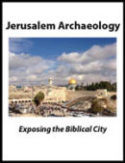
The Benedictine Monastery of the Resurrection in Abu Ghosh, Israel. Hagai Agmon-Snir حچاي اچمون-سنير חגי אגמון-שניר, CC BY-SA 4.0, via Wikimedia Commons.
Seasoned visitors to Jerusalem surely know the Church of St. Anne, a pristinely preserved 12th-century Crusader church in the Romanesque style, near the beginning of the Via Dolorosa. Tradition associates the church’s grotto with the birthplace of Jesus’s mother, Mary, securing its importance for Christian pilgrims. Archaeology aficionados will value the ruins of the Pool of Bethesda, reflecting Jewish, Roman, and Byzantine history, which are located on the same compound as the church. Music enthusiasts will appreciate the structure’s unequaled acoustics: If you stand in the center of the edifice and hum softly, the sound will carry toward the entryway.
Yet there is one thing the Church of St. Anne largely lacks: color. Some assume that the Crusaders who built the structure and worshiped in it were rather austere. But a better explanation relates to the building’s later history. The Church of St. Anne owes its preservation to Jerusalem’s medieval conqueror, Saladin, who transformed the building into a madrasa—an Islamic religious school. (The Arabic inscription over the entryway commemorates this.) The colorlessness of the current church likely results, more than anything else, from the aniconic sensitivity of its pious scholastic occupants.

To get a sense for the Crusaders’ taste for pictorial art, head out to the Benedictine Monastery of the Resurrection in the village of Abu Ghosh, just off the main highway barely 6 miles west of Jerusalem’s edge. Here, too, one can visit a well-preserved 12th-century Crusader basilica—one Saladin’s forces neither destroyed nor repurposed. At turns abandoned or used as a barn, the building fell into disrepair until France purchased it in 1899. Slight traces of the Byzantine-style frescoes remained visible, and these were brilliantly cleaned and restored by teams of experts from 1995 to 2001.
The frescoes are not merely colorful but fascinating. The central apse image depicts Jesus’s legendary descent into hell—during the days between his death and resurrection.a Jesus’s crucifixion is portrayed on the church’s southern wall. Unfortunately, the central figure—Jesus—is poorly preserved, but his two hands are visible, flat against the crossbeam. Better preserved are the images of the two criminals crucified on either side of Jesus (Mark 15:27), each figure hanging on a cross barely wide enough to support his upper arms.

Crusader-era frescoes from the Monastery of the Resurrection. By Alex Ostrovskiy – Own work, CC BY-SA 4.0.
As you absorb the feel of the place, resist the temptation to test the acoustics. Worship services excepted, silence reigns in this basilica.
Stairs in the back of the structure lead down to the crypt, whose center is not a grave but a spring, dating back to Roman times. The Crusaders associated this location with the Emmaus of Luke 24:13-35, where the resurrected Jesus appears to two of his followers. The church’s current authorities are less certain. Hedging the bet, they refer to the “Emmaus of the Crusaders.”
Use of the site during the Roman period is in any event assured. As you exit the structure from the crypt, turn around and look to the left of the crypt’s doorway, where you can see an inscription bearing the unmistakable marks of Rome’s Tenth Legion, a detachment of which was stationed there. As you stand outside the church and appreciate its well-manicured gardens, you will also see the towering minaret of Abu Ghosh’s historic mosque, named, curiously enough, for Uzair (aka Ezra; Quran 9:30).
Abu Ghosh can be reached by car, cab, or bus (line 185 departs near Jerusalem’s central bus station). There is a small gift shop in the monastery and other travel services just outside. Abu Ghosh is well known for its Middle Eastern fare—its hummus above all—so you need not go hungry before catching a cab or a bus back to Jerusalem.
Jonathan Klawans is Professor of Religion at Boston University and author of Heresy, Forgery, Novelty: Condemning, Denying, and Asserting Innovation in Ancient Judaism (2019).
Notes
a. John Dominic Crossan and Sarah Sexton Crossan, “Resurrecting Easter: Hunting for the Original Resurrection Image,” BAR, March/April 2019.
Read more by Jonathan Klawans in Bible History Daily:
Read more in the BAS Library:
Resurrecting Easter: Hunting for the Original Resurrection Image
Not a BAS Library or All-Access Member yet? Join today.The post Colorful Crusader Churches appeared first on Biblical Archaeology Society.


0 Commentaires